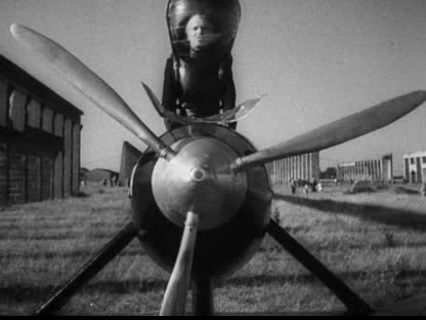Things to Come

From the Battle
of Britain to the moon, 1940-1970, one of the most stupendous works of the
entire cinema.
Endless
influences, primarily Mrs. Miniver
for Everytown at peace (dir. William Wyler), Invasion of the Body Snatchers for the onset of “Wandering
Sickness” (dir. Don Siegel), Fahrenheit
451 for the landscape of The Boss (dir. FranÁois Truffaut), and La Belle et la BÍte for the firing of
the space gun (dir. Jean Cocteau).
Vincent
Korda’s latter designs are realized in the work of the architect John
Portman. The score by Sir Arthur Bliss has a principal role in the film.
Frank
S. Nugent of the New York Times,
“absorbing, provocative and impressively staged”. Kubrick extensively recalls the ruins of Everytown
in Full Metal Jacket.
Cinematography
Perinal, camera Krasker.
“No more
bosses, civilization is to command” (cf.
Dassin’s La Loi).
“Skies,
snowy mountains, blue seas, sunshine, palms—”
“—If
I had my way you could fly to all that in a couple of hours.” 2036, an even hundred years from the time of filming. “An end to progress! Make an end to this progress now!
Let this be the last day of the scientific age... and so we end an age!”
Variety, “an impressive but dull exposition of a bad
dream.” Time Out, “just as
silly” as Fritz Lang’s Metropolis.
Leonard Maltin, “stunning
visualization... aloof but always interesting.” Here was reason
enough for Kubrick to go to England for 2001:
A Space Odyssey (as Welles to RKO after Pichel & Holden’s She). “And when he has conquered
all the deeps of space and all the mysteries of time, still he will be
beginning.”
Halliwell’s Film Guide’s remarks are unimportant (“bits of
the script and acting may be wobbly, but...”), the Sunday Times is quoted to effect, “a
leviathan among films.” Otis Ferguson (The New Republic) plumped down for Theotocopulos
(the rest “vague and full of wind”), Don Herold
(cited by Halliwell) likewise, Graham Greene too, munching on a curate’s
egg (“a third of the film is magnificent”) for The Spectator quite happily.
The monumental
sculpture underway in the artist’s studio where Theotocopulos
conceives his speech to all the great wide world is
remembered by Tony Hancock in The Rebel
(dir. Robert Day).
The Green Cockatoo
It is enough in
six reels for two films twice as long, but critics have only vaguely noticed
certain details of style and Graham Greene’s signature, rather guessing
at the rest.
The satirical
impulse is acknowledged in a Warner Brothers crime veneer honestly bought and
paid for with John Mills in a Cagney fistfight toward the end. He is a tenor at
the club in the title, a girl from the country (Rene Ray) meets up with him and
together they return to her small town.
That is the
simple plot, the major complication is the death of his brother (Robert
Newton), she’s thought to be implicated.
They fix
dog-racing in the city, an investigation is underway. The brother is told to
fix a race, but bets on the dog instead, he’s rubbed out.
The girl rides
into town with a self-described philosopher who warns her of the evils and
gives her a telephone number to call for accommodations, Whitehall 1212,
Scotland Yard, as the dying brother observes later.
Drums in the Deep South
Sherman’s march
to Atlanta is delayed by a gun battery atop Devil’s Mountain.
Menzies adopts a
rare combination of highly artistic settings and close, exclusive camerawork
typical of his style.
Invaders from Mars
The greatest
piece of cod served the public between Welles’ The War of the Worlds radio broadcast and Cornfield’s The Night of the Following Day, in the
purest essence of Menzies’ style, allowed delicately to fray as an
annunciation of the nightmare’s end.